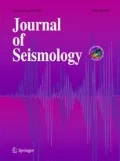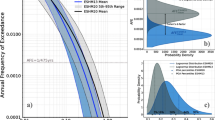Abstract
Bayesian probability theory is an appropriate and useful method for estimating parameters in seismic hazard analysis. The analysis in Bayesian approaches is based on a posterior belief, also their special ability is to take into account the uncertainty of parameters in probabilistic relations and a priori knowledge. In this study, we benefited the Bayesian approach in order to estimate maximum values of peak ground acceleration (Amax) also quantiles of the relevant probabilistic distributions are figured out in a desired future interval time in Iran. The main assumptions are Poissonian character of the seismic events flow and properties of the Gutenberg-Richter distribution law. The map of maximum possible values of Amax and also map of 90% quantile of distribution of maximum values of Amax on a future interval time 100 years is presented. According to the results, the maximum value of the Amax is estimated for Bandar Abbas as 0.3g and the minimum one is attributed to Esfahan as 0.03g. Finally, the estimated values in Bayesian approach are compared with what was presented applying probabilistic seismic hazard (PSH) methods based on the conventional Cornel (1968) method. The distribution function of Amax for future time intervals of 100 and 475 years are calculated for confidence limit of probability level of 90%.






Similar content being viewed by others
References
Bayrak Y, Türker T (2016) The determination of earthquake hazard parameters deduced from Bayesian approach for different seismic source regions of western Anatolia. Pure Appl Geophys 173(1):205–220
Bayrak Y, Türker T (2017) Evaluating of the earthquake hazard parameters with Bayesian method for the different seismic source regions of the north Anatolian fault zone. Nat Hazards 85(1):379–401
Benjamin JR, Cornell CA (1970) Probability statistics and decision for civil engineers. McGraw-Hill, New York
Boore DM, Atkinson GM (2008) Ground-motion prediction equations for the average horizontal component of PGA, PGV, and 5%-damped PSA at spectral periods between 0.01 s and 10.0 s. Earthquake Spectra 24(1):99–138
Boostan E, Tahernia N, Shafiee A (2015) Fuzzy—probabilistic seismic hazard assessment, case study: Tehran region, Iran. Nat Hazards 77(2):525–541
Campbell KW, Bozorgnia Y (2008) NGA ground motion model for the geometric mean horizontal component of PGA, PGV, PGD and 5% damped linear elastic response spectra for periods ranging from 0.01 to 10 s. Earthquake Spectra 24(1):139–171
Chiou BJ, Youngs RR (2008) An NGA model for the average horizontal component of peak ground motion and response spectra. Earthquake Spectra 24(1):173–215
Cornell CA (1968) Engineering seismic risk analysis. Bull Seismol Soc Am 58(5):1583–1606
Cox DR, Lewis PAWL (1966) The statistical analysis of series of events. Published by Methuen, London
Frankel A. (1995) Mapping seismic hazard in the central and eastern United States. Seismol Res Lett 66(4):8–21
Galanis OC, Tsapanos TM, Papadopoulos GA, Kiratzi AA (2002) Bayesian extreme values distribution for seismicity parameters assessment in South America. Journal of the Balkan Geophysical Society (BGS) 5(3):77–86
Gardner JK, Knopoff L (1974) Is the sequence of earthquakes in Southern California, with aftershocks removed, Poissonian? Bull Seismol Soc Am 64(5):1363–1367
Ghodrati Amiri G, Amrei, S.R. (2008) Seismic hazard assessment of Gilan province including Manjil in Iran. In Proc. 14th World Conf. Earthquake Eng. Beijing, China
Golara A (2014) Probabilistic seismic hazard analysis of interconnected infrastructure: a case of Iranian high-pressure gas supply system. Nat Hazards 73(2):567–577
Hardle W (1989) Applied nonparametric regression. Cambridge University Press, Cambridge
Kelly D, Smith C (2011) Bayesian inference for probabilistic risk assessment: a practitioner’s guidebook. Springer Science and Business Media
Khodaverdian A, Zafarani H, Rahimian M, Dehnamaki V (2016) Seismicity parameters and spatially smoothed seismicity model for Iran. Bull Seismol Soc Am 106(3):1133–1150
Khoshnevis N, Taborda R, Azizzadeh-Roodpish S, Cramer CH (2017) Seismic hazard estimation of northern Iran using smoothed seismicity. J Seismol 21(4):941–964
Lyubushin AA, Parvez IA (2010) Map of seismic hazard of India using Bayesian approach. Nat Hazards 55(2):543–556
Lyubushin AA, Tsapanos TM, Pisarenko VF, Koravos GC (2002) Seismic hazard for selected sites in Greece: a Bayesian estimate of seismic peak ground acceleration. Nat Hazards 25(1):83–98
Mirzaei N, Gao M, Chen YT (1998) Seismic source regionalization for seismic zoning of Iran: major seismotectonic provinces. Journal of Earthquake Prediction Research (JEPR) 7:465–495
Mohammadi H, Türker T, Bayrak Y (2016) A quantitative appraisal of earthquake hazard parameters evaluated from bayesian approach for different regions in Iranian Plateau. Pure Appl Geophys. https://doi.org/10.1007/s00024-016-1264-5
Moinfar AA, Naderzadeh A, Maleki E (2000) A new seismic hazard map for the implementation in the national physical planning of Iran. In Earthquake hazard and seismic risk reduction (pp. 289–296). Springer, Dordrecht
Moinfar AA, Naderzadeh A, Nabavi MH (2012) New Iranian seismic hazard zoning map for new edition edition of seismic code and its comparison with neighbor neighbor countries. In 15th World Conference on Earthquake Engineering
Mousavi Bafrouei SH, Mirzaei N, Shabani E, Eskandari-Ghadi M (2014) Seismic hazard zoning in Iran and estimating peak ground acceleration in provincial capitals. Earth and Space Physics 4:40 (In Persian)
Mousavi Bafrouei SH, Mirzaei N, Shabani E (2015) A declustered earthquake catalog for the Iranian Plateau. Ann Geophys 57(6). https://doi.org/10.4401/ag-6395
Pisarenko VF, Lyubushin AA (1997) Statistical estimation of maximum peak ground acceleration at a given point of a seismic region. J Seismol 1(4):395–405
Pisarenko VF, Lyubushin AA (1999) Bayesian approach to seismic hazard estimation: maximum values of magnitudes and peak ground accelerations, Earthquake research in China (English edition). 13:45–57
Pisarenko VF, Lyubushin AA, Lysenko VB, Golubeva TV (1996) Statistical estimation of seismic hazard parameters: maximum possible magnitude and related parameters. Bull Seismol Soc Am 86(3):691–700
Rao CR (1965) Linear statistical inference and its application. Wiley, New York, pp 1–618
Ruzhich VV, Levina EA, Pisarenko VF, Lyubushin AA (1998) Statistical estimation of the maximum possible earthquake magnitude for the Baikal Rift Zone. Russ Geol Geophys Geol Geofiz 39(10):1445–1457
Shi Z, Yan J, Gao M (1992) Research on the principle and methodology of seismic zonation. Acta Seismol Sin 5(2):305–314
Shoja-Taheri J, Naserieh S, Hadic G (2010) A test of the applicability of NGA models to the strong ground-motion data in the Iranian Plateau. J Earthq Eng 14(2):278–292
Tavakoli B, Ghafory-Ashtiany M (1999) Seismic hazard assessment of Iran. Ann Geophys 42(6):1013–1021
Tsapanos TM (2003) Appraisal of seismic hazard parameters for the seismic regions of the East Circum-Pasific Belt inferred from a Bayesian approach. Nat Hazards 30(1):59–78
Tsapanos TM, Christova CV (2003) Earthquake hazard parameters in Crete Island and its surrounding area inferred from Bayes statistics: an integration of morphology of the seismically active structures and seismological data. Pure Appl Geophys 160(8):1517–1536
Tsapanos TM, Lyubushin AA, Pisarenko VF (2001) Application of a Bayesian approach for estimation of seismic hazard parameters in some regions of the Circum-Pasific Belt. Pure Appl Geophys 158(5–6):859–875
Vafaie J, Taghikhany T, Tehranizadeh M (2011) Near field effect on horizontal equal-hazard spectrum of Tabriz city in north-west of Iran. International Journal of Civil Engineering 9(1):49–56
Yadav RBS, Tsapanos TM, Bayrak Y, Koravos GCH (2012) Probabilistic appraisal of earthquake hazard parameters deduced from a Bayesian approach in the northwest frontier of the Himalayas. Pure Appl Geophys 170(3):283–297
Yadav RBS, Tsapanos TM, Tripathi JN, Chopra S (2013) An evaluation of tsunami hazard using Bayesian approach in the Indian Ocean. Tectonophysics 593:172–182
Zare M (2012) Development of seismic hazard zoning map for Iran, based on new seismic source determination. In Proceedings 15th world conference on earthquake engineering, Lisboa, Portugal September (pp. 24–28)
Acknowledgements
The authors gratefully thank the anonymous referees for the constructive comments, which significantly improved this article. The authors would like to acknowledge the financial support of University of Tehran for this research under grant number 28625/1/03.
Author information
Authors and Affiliations
Corresponding author
Rights and permissions
About this article
Cite this article
Salahshoor, H., Lyubushin, A., Shabani, E. et al. Comparison of Bayesian estimates of peak ground acceleration (Amax) with PSHA in Iran. J Seismol 22, 1515–1527 (2018). https://doi.org/10.1007/s10950-018-9782-5
Received:
Accepted:
Published:
Issue Date:
DOI: https://doi.org/10.1007/s10950-018-9782-5




